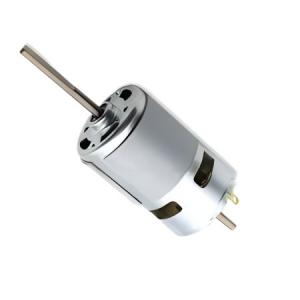
Add to Cart
Essential Details
Model Number: KG-2966DC36
Noise: Low Noise Level
Warranty: 3 Years
Place of Origin: Guangdong, China
Application: Electric Tools
Rated Voltage: 12-36V
Torque: 350~1000gf.cm
Efficiency: IE 4
Size: Diameter 42mm
Key Word: DC Motor
Rated Speed: 3000~12000RPM
Power: 0.5W Max
Continuous Current: No load 110~1800mA
Lead Time
| Quantity | 1-1000 | 1001-10000 | ≥10000 |
| Lead days | 15 | 30 | To be negotation |
Product Description
| Rated Voltage | 12-36V | Rated Speed | 3000-12000RPM |
| Power | 0.5W Max | Continuous Current | No load 110~1800mA |
Drawing

Sample

Application

Working Principle Of DC Motor
Motor works on the principle of Loretz force principle. Whenever a current-carrying conductor placed in a magnetic field then there will be a force produced in the conductor. The two fluxes oppose each other. Here, the field flux is produced by the field winding and the armature flux is produced by the armature winding when the armature is given an electric input.
We know that every current-carrying conductor will produce flux. Therefore, the armature current will also produce flux. The direction of the flux produced by the armature conductor is determined by the right-hand thumb rule and the direction of the armature conductor can be determined.
These two fluxes i.e., armature flux and main field flux will interact with each other by which the net flux will be increased towards one side and which will be minimum on the other side.
The increased flux on one side will be in the shape of an enlarged magnetic field or flux or like a stretched rubber band. Therefore, this will exert a force on the surface of the conductor by which there will be momentum in the conductor.
As the armature is in a cylindrical shape and has a radius, therefore, a force will be created on the surface of the armature which leads to turning or twisting which is called as production of torque.
Significance Of Back EMF
When the motor is operating then the concept of generator comes into the picture i.e., whenever the flux linking with the conductor changes then there will be an induced emf in the conductor. Here, the flux produced by the poles will be stationary and constant and because of the motor principle, the armature starts rotating.
Because the armature starts rotating the flux produced by the main field will be cut by the armature conductor and therefore there will be an induced emf in the armature conductor according to the generator principle.
We know that the direction of the induced emf produced by the motor is opposite to the applied voltage. But the magnitude of the induced emf will be similar to that of the induced emf of the generator.